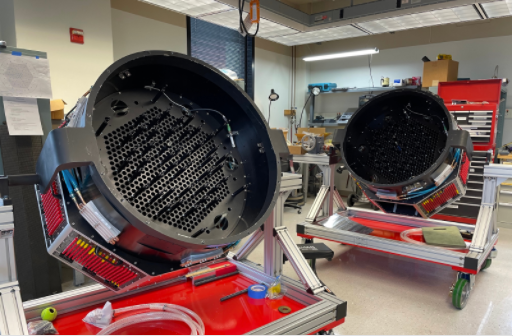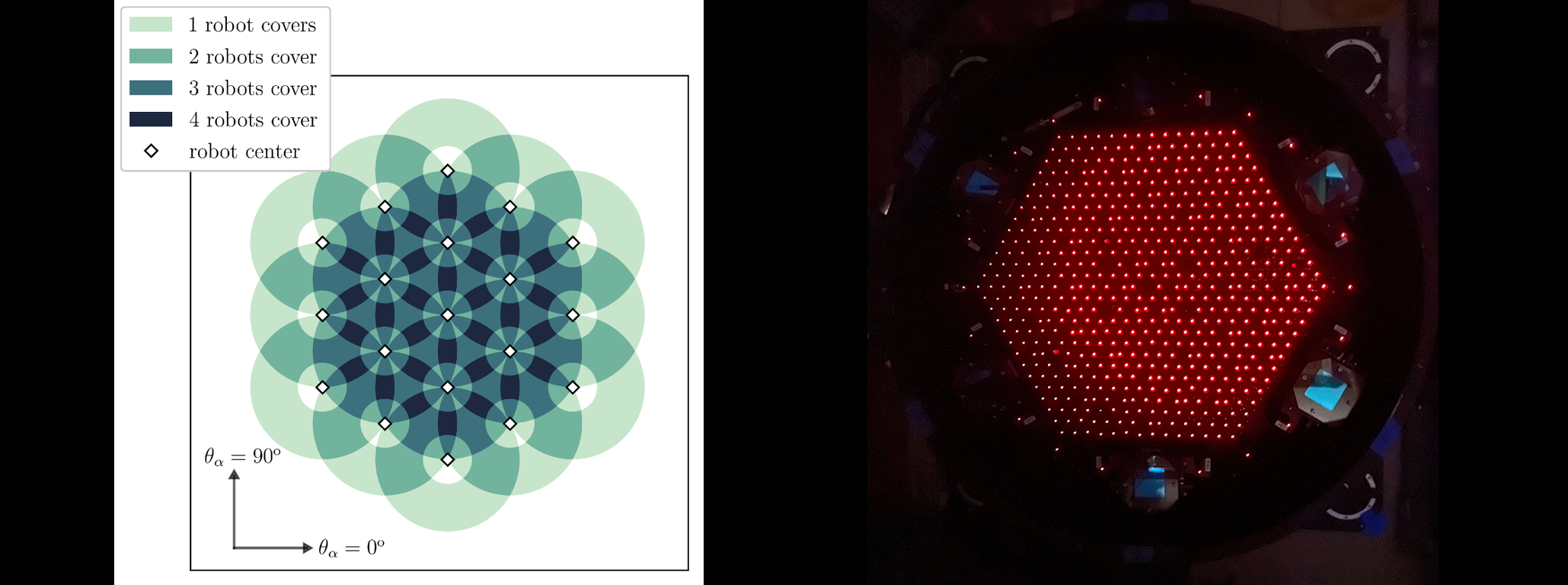After twenty-one years of observers loading heavy aluminum plates night after night, the Sloan Digital Sky Survey (SDSS) is now seeing the cosmos through robotic eyes. Following more than five years of design, development and construction, survey members worked over the final months of 2021 to install the new robotic Focal Plane System (FPS) on the Sloan Foundation 2.5m Telescope at Apache Point Observatory (APO).
LEFT: interaction zone modeling for a subset of robots in the focal plane of the telescope
RIGHT: The APO FPS with its fibers uncovered and backlit
Image credit:
LEFT: from Sayres et al. 2021
RIGHT: Richard Pogge, The Ohio State University
“We are thrilled to have reached this technological milestone despite being in the midst of a global pandemic and are excited to witness how this shift will enhance the work of the project,” said Professor Juna Kollmeier, director of this fifth phase of the SDSS and the director of the Canadian Institute for Theoretical Astrophysics (CITA) at the Faculty of Arts & Science at the University of Toronto. “This project has been truly collaborative, involving the contributions of scientists at more than 50 institutions from around the world.”
Previously, optical fibers were plugged into plates by hand. That system has been replaced by hundreds of high-precision robots that can put fibers anywhere in the focal plane. The system now installed at APO is the first of two units; its twin is currently under construction and will soon head to Las Campanas Observatory in Chile to survey the southern sky.
“This new system is a huge accomplishment for the fifth phase of SDSS,” said Gail Zasowski, a professor at the University of Utah and the SDSS-V project spokesperson. “It’s been an exciting road to this point, sometimes fraught with challenges, but it’s wonderful to have arrived here at last!”

Image credit: The SDSS collaboration
The development of the new robotic FPS is a global effort built by an international team, including Ohio State University’s Imaging Sciences Laboratory, the University of Washington, École Polytechnique Fédérale de Lausanne (EPFL) and the Carnegie Observatories in Pasadena. These design teams overcame numerous challenges posed by the global pandemic by developing and constructing components wherever they were – some in their own garages and backyards – and shipping them elsewhere for further assembly. The robots were built in Switzerland and integrated into the main mechanical units in Columbus, Ohio. From there, they traveled to their final home in New Mexico — and soon, they will head to Chile as well.
Richard Pogge, the FPS Lead and a professor at Ohio State, noted, “OSU has built many exciting instruments, but this was new for us. It has been a challenging project for our team and a great success.”
The FPS will enable two of the three core science programs in SDSS-V: the Milky Way Mapper (MWM) and the Black Hole Mapper (BHM). Together, these projects will collect data from millions of objects spread across the sky, from stars in our own galactic backyard to unimaginably distant supermassive black holes.
“Developing the control software for the FPS has been a very challenging and extremely rewarding process” said Jose-Sanchez Gallego, an assistant professor at the University of Washington, who leads the controls and operations team along with graduate student Conor Sayres. “When we got the first light down the robotic fibres, we knew the last three years of teamwork had been worth it.” Solange Ramirez, an astronomer at the Carnegie Observatories and the Project Manager of SDSS-V added “This is such a major milestone for SDSS-V, its success had required a major technical and coordination effort.
The MWM will study our home galaxy in unprecedented detail. The ecosystem of stars, gas, dust and dark matter in large galaxies like our own has been shaped over billions of years by numerous physical processes that dominate on different scales in space and time. It will take advantage of our unique perspective within the Milky Way Galaxy to create a uniquely high-resolution map of the galaxy’s stars and how they are moving.
The MWM will also measure masses, ages, chemical compositions, the presence of companions, and a slew of other properties for vast samples of stars of all types — including hot massive stars, stars that are just forming, and the white dwarfs that are dead remnants of stars like our Sun. It will also target tens of thousands of multi-star and planetary systems in order to understand how often multi-companion systems form and what determines how they are structured.
“Without the observing speed and flexibility that the FPS gives us, it would be simply impossible to target so many objects across the entire sky,” said Jennifer Johnson, a professor at Ohio State and head of the MWM team.
Contacts
- Steven Majewski, University of Virginia, +1-434-924-4893, srm4n@virginia.edu
- Rachael Beaton, Princeton University, +1-434-760-1404, rbeaton@princeton.edu
- Karen Masters, SDSS-IV Spokesperson, Haverford College, 610-795-6066, klmasters@haverford.edu
Twitter: @KarenLMasters / @SDSSurveys - Jordan Raddick, SDSS-IV Press Officer, Johns Hopkins University, 443-570-7105, raddick@jhu.edu
Looking farther afield, the BHM will study quasars, which are among the most luminous objects in the universe. Powered by accretion onto supermassive black holes at the centres of galaxies, quasars can be used as beacons to trace the growth of these titans over cosmic time. SDSS-V will collect data on more than 300,000 quasars to measure the masses of their black holes, understand the physics of how they gobble up matter, and trace their growth over many billions of years.
By observing these objects many times, and combining the data with earlier SDSS observations, SDSS-V will be able to see how these systems evolve on timescales ranging from days to decades. The survey will also provide follow-up observations of hundreds of thousands of sources identified at X-ray wavelengths by the SRG/eROSITA satellite, to determine their nature and their distance. This vast sample of sources will include not only new quasars, but also distant clusters of galaxies — the largest gravitationally bound structures in the universe — as well as nearby X-ray-emitting stars.
These vast samples of strikingly different types of targets — millions of Milky Way stars, hundreds of thousands of distant quasars — are among the key aspects that set SDSS-V apart from other surveys and are enabled by the new FPS system.
Hans-Walter Rix of the Max-Planck-Institute for Astronomy in Heidelberg, Germany, the SDSS-V Project Scientist, remarked, “In addition to probing even larger numbers of objects than before, the agile observing mode enabled by the FPS is the key to observing objects repeatedly, opening up the physics of changing and variable objects in the sky to systematic study.”
Added Kollmeier, “The SDSS team is an inspiration. While the world was shutting down, they were showing up. Everyone from the undergraduate students to the project leadership to our industry partners kept at it as best they could and supported each other to get here. I am so proud of this team’s perseverance and I look forward to the mysteries we both solve and uncover as the survey gets underway in full force.”
Press Releases
All prior SDSS press releases can be found in the press release archives of the various phases of the SDSS:
SDSS-IV Press Release archive
SDSS-III Press Release archive
SDSS-I/-II Press Release archive
About the Sloan Digital Sky Survey
Funding for the Sloan Digital Sky Survey IV has been provided by the Alfred P. Sloan Foundation, the U.S. Department of Energy Office of Science, and the Participating Institutions. SDSS acknowledges support and resources from the Center for High-Performance Computing at the University of Utah.
Funding for the Sloan Digital Sky Survey V has been provided by the Alfred P. Sloan Foundation, the Heising-Simons Foundation, and the Participating Institutions. SDSS acknowledges support and resources from the Center for High-Performance Computing at the University of Utah. The SDSS web site is www.sdss5.org.
SDSS is managed by the Astrophysical Research Consortium for the Participating Institutions of the SDSS Collaboration, including the Carnegie Institution for Science, Chilean National Time Allocation Committee (CNTAC) ratified researchers, the Gotham Participation Group, Harvard University, Heidelberg University, The Johns Hopkins University, L’Ecole polytechnique fédérale de Lausanne (EPFL), Leibniz-Institut für Astrophysik Potsdam (AIP), Max-Planck-Institut für Astronomie (MPIA Heidelberg), Max-Planck-Institut für Extraterrestrische Physik (MPE), Nanjing University, National Astronomical Observatories of China (NAOC), New Mexico State University, The Ohio State University, Pennsylvania State University, Smithsonian Astrophysical Observatory, Space Telescope Science Institute (STScI), the Stellar Astrophysics Participation Group, Universidad Nacional Autónoma de México, University of Arizona, University of Colorado Boulder, University of Illinois at Urbana-Champaign, University of Toronto, University of Utah, University of Virginia, and Yale University.




